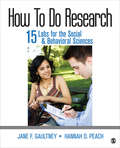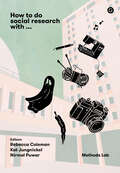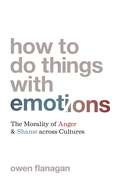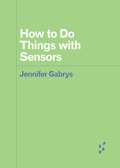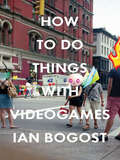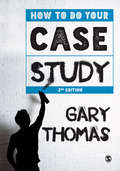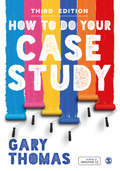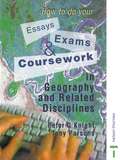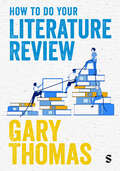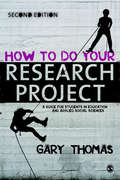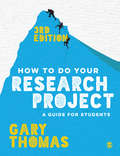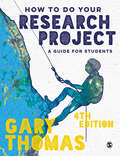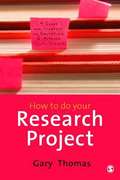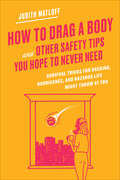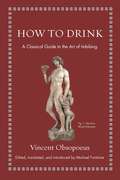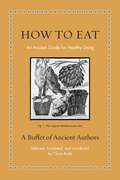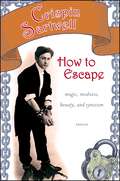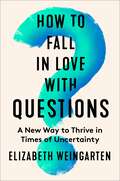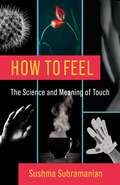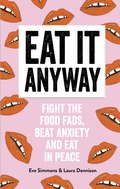- Table View
- List View
How To Do Research: 15 Labs for the Social & Behavioral Sciences
by Jane F. Gaultney Hannah D. PeachDesigned to help students make the leap from learning about research to doing research, How To Do Research by Jane F. Gaultney and Hannah D. Peach provides an easy-to-understand walkthrough of the entire research process, from selecting a topic and conducting a literature review through presenting an APA-style paper or presentation. All of the 15 cross-disciplinary labs included are appropriate for use in the social, behavioral, and health sciences, and follow a consistent format: objective, description of a journal article, canned data, examples of what output should look like, pointers on interpreting the output, and a suggested activity for those who wish to collect their own data.
How To Do Social Research With (Goldsmiths Press / Methods Lab)
by Rebecca Coleman Kat Jungnickel Nirmal PuwarA guide to the doing of critical and creative research with a range of unusual means to apprise places and build ethical relationships.This catalogue of methods draws on the wealth of cutting-edge critical and creative social research from the Goldsmiths Sociology Department to offer an engaged guide to doing research with a range of unexpected relations. The collection focuses on multiple assemblages of objects, media, materials, practices, relations, devices, and atmospheres, spanning methods and topics involving food to activism, knitting to ghosts, theater to documents, collaging to corridors. Through hands-on discussions of the practicalities, ethics, and politics of doing social research, the catalogue showcases a wide range of examples of what methods might mean and do. It builds a case for an understanding of contemporary social research as interdisciplinary, responsive, dynamic, vital, and urgent in studying and shaping social worlds. Goldsmiths Sociology Department is internationally recognized as being at the forefront of some of the most daring, original and unconventional methodological innovation. Their unbounded approach to social research offers textured yet clear paths through the problems and issues before us, as contributors present the methodological puzzles they have become knotted with. The short and imaginative case studies offer new ways of teaching, learning, and doing lively and rigorous research. This is research as close-up observations, infrastructural interventions and imaginative play. How to Do Social Research With … will be essential for anyone interested in expanding their repertoire of social research methods.
How to Do Things with Emotions: The Morality of Anger and Shame across Cultures
by Owen FlanaganAn expansive look at how culture shapes our emotions—and how we can benefit, as individuals and a society, from less anger and more shameThe world today is full of anger. Everywhere we look, we see values clashing and tempers rising, in ways that seem frenzied, aimless, and cruel. At the same time, we witness political leaders and others who lack any sense of shame, even as they display carelessness with the truth and the common good. In How to Do Things with Emotions, Owen Flanagan explains that emotions are things we do, and he reminds us that those like anger and shame involve cultural norms and scripts. The ways we do these emotions offer no guarantee of emotionally or ethically balanced lives—but still we can control and change how such emotions are done. Flanagan makes a passionate case for tuning down anger and tuning up shame, and he observes how cultures around the world can show us how to perform these emotions better.Through comparative insights from anthropology, psychology, and cross-cultural philosophy, Flanagan reveals an incredible range in the expression of anger and shame across societies. He establishes that certain types of anger—such as those that lead to revenge or passing hurt on to others—are more destructive than we imagine. Certain forms of shame, on the other hand, can protect positive values, including courage, kindness, and honesty. Flanagan proposes that we should embrace shame as a uniquely socializing emotion, one that can promote moral progress where undisciplined anger cannot.How to Do Things with Emotions celebrates the plasticity of our emotional responses—and our freedom to recalibrate them in the pursuit of more fulfilling lives.
How to Do Things with Sensors (Forerunners: Ideas First)
by Jennifer GabrysAn investigation of how-to guides for sensor technologies Sensors are increasingly common within citizen-sensing and DIY projects, but these devices often require the use of a how-to guide. From online instructional videos for troubleshooting sensor installations to handbooks for using and abusing the Internet of Things, the how-to genres and formats of digital instruction continue to expand and develop. As the how-to proliferates, and instructions unfold through multiple aspects of technoscientific practices, Jennifer Gabrys asks why the how-to has become one of the prevailing genres of the digital. How to Do Things with Sensors explores the ways in which things are made do-able with and through sensors and further considers how worlds are made sense-able and actionable through the instructional mode of citizen-sensing projects.Forerunners: Ideas FirstShort books of thought-in-process scholarship, where intense analysis, questioning, and speculation take the lead
How to Do Things with Videogames (Electronic Mediations)
by Ian BogostIn recent years, computer games have moved from the margins of popular culture to its center. Reviews of new games and profiles of game designers now regularly appear in the New York Times and the New Yorker, and sales figures for games are reported alongside those of books, music, and movies. They are increasingly used for purposes other than entertainment, yet debates about videogames still fork along one of two paths: accusations of debasement through violence and isolation or defensive paeans to their potential as serious cultural works. In How to Do Things with Videogames, Ian Bogost contends that such generalizations obscure the limitless possibilities offered by the medium&’s ability to create complex simulated realities. Bogost, a leading scholar of videogames and an award-winning game designer, explores the many ways computer games are used today: documenting important historical and cultural events; educating both children and adults; promoting commercial products; and serving as platforms for art, pornography, exercise, relaxation, pranks, and politics. Examining these applications in a series of short, inviting, and provocative essays, he argues that together they make the medium broader, richer, and more relevant to a wider audience.Bogost concludes that as videogames become ever more enmeshed with contemporary life, the idea of gamers as social identities will become obsolete, giving rise to gaming by the masses. But until games are understood to have valid applications across the cultural spectrum, their true potential will remain unrealized. How to Do Things with Videogames offers a fresh starting point to more fully consider games&’ progress today and promise for the future.
How to Do Your Case Study
by Gary ThomasVibrant and insightful, this book introduces students and researchers to the basics of case study research. Adopting jargon-free language, it grounds its advice in concrete experience and real-world cases. Using examples from across the social sciences, Gary Thomas provides practical guidance on how best to read, design and carry out case study research with a focus on how to manage and analyze data. The new edition of this bestselling book addresses crucial issues around ethics and has improved coverage of key themes such as rigor, validity, generalization and the analysis of case studies. It demystifies case study research and answers important questions such as: What is a case study? When and why should case study methods be used? How are case studies designed? What methods can be used? How do we analyze and make sense of our data? How do we write up and write about our case? Bursting with real-world examples and multidisciplinary cases, and supported by a dynamic new website, this book is essential reading for any student or researcher in the social sciences and humanities.
How to do Your Case Study
by Gary ThomasThis accessible text introduces students and researchers to the basics of case study research, using a wide range of real-life examples. It deals with the core issues and methods that anyone new to case study will need to understand: What is a case study? When and why should case study methods be used? How are case studies designed? What methods can be used? How do we analyze our data and write up our case?
How to Do Your Case Study
by Gary ThomasThis accessible guide takes you through the process of designing, conducting and writing up a research project using case study methods. In his characteristic warm and friendly style, Gary Thomas covers each step at a confidence-building pace, helping you to get to grips with the theory and practice of doing a case study. Focusing on vital issues like validity, reliability and quality in research, the author helps you ensure your research is rigorous and methodologically sound. This third edition: · Offers an expanded discussion of key ethical issues in case study research · Provides up to date information about using social media in research · Presents a new navigation tool to help you plan your case study project · Enables you to develop the skills you need to become a critical and reflexive researcher Covering international examples of case study in practice and accompanied by downloadable checklists and templates, this book is the perfect companion to help you successfully complete a case study.
How to Do Your Case Study
by Gary ThomasThis accessible guide takes you through the process of designing, conducting and writing up a research project using case study methods. In his characteristic warm and friendly style, Gary Thomas covers each step at a confidence-building pace, helping you to get to grips with the theory and practice of doing a case study. Focusing on vital issues like validity, reliability and quality in research, the author helps you ensure your research is rigorous and methodologically sound. This third edition: · Offers an expanded discussion of key ethical issues in case study research · Provides up to date information about using social media in research · Presents a new navigation tool to help you plan your case study project · Enables you to develop the skills you need to become a critical and reflexive researcher Covering international examples of case study in practice and accompanied by downloadable checklists and templates, this book is the perfect companion to help you successfully complete a case study.
How to do your Essays, Exams and Coursework in Geography and Related Disciplines
by Peter Knight Tony ParsonsWritten for students who need help doing their coursework and exams, this book focuses mainly on the skills and techniques that apply to essay writing, but also covers other types of assignment such as posters, talks, PowerPoint^DTM presentations and web pages. Its basis is that all of these different types of work are centred on clear communication of well-supported responses to the questions or tasks that have been set.
How to Do Your Literature Review
by Gary ThomasThis book will walk you through every step of crafting an excellent literature review. It will show you where to find sources, how to assess their quality, and how to combine and integrate these sources into the best possible literature review. From scoping the field to searching the literature to synthesising your findings, this book hits all the spots. Presenting a clear and detailed roadmap to ensure you don’t miss a step, the book includes: · Advice on the best ways to scan and search the literature. · All the latest information and advice on using AI tools for searching literature. · Case studies and real-life examples from a range of disciplines so you can learn from other researchers who have been in your shoes. · DIY activities so you can practice your skills and get to grips with key concepts. · Guidance on how to analyse and synthesise the findings from your literature searches. · Advice and guidance on organising your writing. For tutors, each chapter is accompanied by a PowerPoint presentation that will map onto a 10 or 11 week module. Written in Gary’s signature easy-to-read style, this book is an essential companion for anyone conducting a literature review in the applied social sciences.
How to Do Your Literature Review
by Gary ThomasThis book will walk you through every step of crafting an excellent literature review. It will show you where to find sources, how to assess their quality, and how to combine and integrate these sources into the best possible literature review. From scoping the field to searching the literature to synthesising your findings, this book hits all the spots. Presenting a clear and detailed roadmap to ensure you don’t miss a step, the book includes: · Advice on the best ways to scan and search the literature. · All the latest information and advice on using AI tools for searching literature. · Case studies and real-life examples from a range of disciplines so you can learn from other researchers who have been in your shoes. · DIY activities so you can practice your skills and get to grips with key concepts. · Guidance on how to analyse and synthesise the findings from your literature searches. · Advice and guidance on organising your writing. For tutors, each chapter is accompanied by a PowerPoint presentation that will map onto a 10 or 11 week module. Written in Gary’s signature easy-to-read style, this book is an essential companion for anyone conducting a literature review in the applied social sciences.
How to Do Your Research Project
by Dr Gary ThomasDirect, informative and accessible the new edition of Gary Thomas's bestselling title is essential reading for anyone doing a research project. Packed full of relevant advice and real world examples the book guides you through the complete research process. Using refreshingly jargon-free language and anecdotal evidence it is a witty, easy to follow introduction that will answer your questions, set out best practice and walk you through every stage of your project step-by-step. It covers: - How to choose your research question - Project management and study skills - Doing an effective literature review - Methodology, theory and research design - Design frames - Ethics and access - Tools for data collection - Effective data analysis - Discussing findings, concluding and writing up The expanded, insightfully redesigned second edition has a fully integrated companion website including student worksheets, annotated examples and links to SAGE Journals. Gary Thomas also has an exciting new video in which he explains what's new to this Second Edition. This popular book is ideal for anyone undertaking a research project in the applied social sciences.
How to Do Your Research Project: A Guide for Students
by Gary ThomasLecturers, request your electronic inspection copy here. 'Gary’s book, never more than a metre away, has been my indispensable research companion. With its easy layout, my well-worn copy, stripy with florescent marker and pencilled notes, has been my go-to, on-hand supervisor throughout my degree; taking the distance out of distance learning. Replace daunting and impossible with clarity and entertainment. I wouldn’t be where I am today without it; it has been my gateway to achievement' - Ellie Davies Moore, distance learner in Multi-Sensory Impairment at the University of Birmingham With more advice on concluding, writing up and presenting research, using social media and digital methods, and understanding what supervisors want and how to work with them, the third edition of this bestselling title continues to lead the way as an essential guide for anyone undertaking a research project in the applied social sciences. Setting out a clear and detailed road map, Gary Thomas guides the reader through the different stages of a research project, explaining key steps and processes at each level in refreshingly jargon-free terms. It covers: - How to choose your research question - Project management and study skills - Effective literature reviews - Methodology, theory and research design frames - Ethics and access - Data collection tools - Effective data analysis - Discussing findings, concluding and writing up Packed with engaging anecdotal evidence and practical advice and supported by an interactive website featuring worksheets, videos, SAGE Journal articles and more, this new edition is a user-friendly, one-stop-shop for guidance on research principles.
How to Do Your Research Project: A Guide for Students
by Gary ThomasLecturers, request your electronic inspection copy here. 'Gary’s book, never more than a metre away, has been my indispensable research companion. With its easy layout, my well-worn copy, stripy with florescent marker and pencilled notes, has been my go-to, on-hand supervisor throughout my degree; taking the distance out of distance learning. Replace daunting and impossible with clarity and entertainment. I wouldn’t be where I am today without it; it has been my gateway to achievement' - Ellie Davies Moore, distance learner in Multi-Sensory Impairment at the University of Birmingham With more advice on concluding, writing up and presenting research, using social media and digital methods, and understanding what supervisors want and how to work with them, the third edition of this bestselling title continues to lead the way as an essential guide for anyone undertaking a research project in the applied social sciences. Setting out a clear and detailed road map, Gary Thomas guides the reader through the different stages of a research project, explaining key steps and processes at each level in refreshingly jargon-free terms. It covers: - How to choose your research question - Project management and study skills - Effective literature reviews - Methodology, theory and research design frames - Ethics and access - Data collection tools - Effective data analysis - Discussing findings, concluding and writing up Packed with engaging anecdotal evidence and practical advice and supported by an interactive website featuring worksheets, videos, SAGE Journal articles and more, this new edition is a user-friendly, one-stop-shop for guidance on research principles.
How to Do Your Research Project: A Guide for Students
by Gary ThomasStarting your research project can feel daunting, but this best-selling project guide has your back! Now in its fourth edition, the book provides easy to follow advice to navigate every step of your research project, from choosing your research question, deciding on your research design and methodology, collecting and analysing your data, and writing up your finished project. Presenting a clear and detailed roadmap to ensure you don’t miss a step, the book includes: • Case studies and real-life examples from a range of disciplines so you can learn from other researchers who have been in your shoes • DIY activities so you can practise your skills and get to grips with key concepts • Practical advice on how to organise your writing, develop your flow and build strong arguments • Further guidance on assessing ethical risk, including examples of high, medium, and low risk projects Written in Gary’s signature straightforward style, this book is an essential companion for anyone undertaking a research project in the applied social sciences.
How to Do Your Research Project: A Guide for Students
by Gary ThomasStarting your research project can feel daunting, but this best-selling project guide has your back! Now in its fourth edition, the book provides easy to follow advice to navigate every step of your research project, from choosing your research question, deciding on your research design and methodology, collecting and analysing your data, and writing up your finished project. Presenting a clear and detailed roadmap to ensure you don’t miss a step, the book includes: • Case studies and real-life examples from a range of disciplines so you can learn from other researchers who have been in your shoes • DIY activities so you can practise your skills and get to grips with key concepts • Practical advice on how to organise your writing, develop your flow and build strong arguments • Further guidance on assessing ethical risk, including examples of high, medium, and low risk projects Written in Gary’s signature straightforward style, this book is an essential companion for anyone undertaking a research project in the applied social sciences.
How to do Your Research Project: A Guide for Students in Education and Applied Social Sciences
by Gary ThomasAre you doing a research project? Do you need advice on how to carry out research? Does writer's block get in the way of your dissertation?<P><P> Nearly all students need to do a research project at some point during their degree. How to do your Research Project guides you through the different phases of doing so. With practical examples, Thomas explains what should happen at each project phase, detailing the main design frames and methods used in social science research, and providing down to earth and practical advice on weaving these elements together into a coherent whole.
How to Drag a Body and Other Safety Tips You Hope to Never Need: Survival Tricks for Hacking, Hurricanes, and Hazards Life Might Throw at You
by Judith Matloff“Matloff assesses major threats with careful authority and good humor, then gives us the logistical and emotional tools necessary to cope with them.” —Ada Calhoun, New York Times–bestselling author of Why We Can’t SleepIn an age of anxiety, we yearn for some control. We want to make sensible decisions to keep us on track when everything seems to be going off the rails. As a seasoned war correspondent with over thirty years of experience in crisis zones and a pioneering safety consultant, Judith Matloff knows about personal security and risk management. In How to Drag a Body and Other Safety Tips You Hope to Never Need, she shares her tried-and-true methods to help you confidently handle whatever challenges comes your way. Learn how to:Perform emergency first aidCreate a bunkerKeep yourself safe when travelingKeep yourself safe onlineKeep yourself safe in any circumstance with invaluable tips on dozens of other situationsBlending humorous anecdotes with serious advice, Matloff explains how to remain upright in stampedes, avoid bank fraud, prevent sexual assault, stay clean in a shelter, and even be emotionally prepared for loss. From cybersecurity and active shooter situations to natural disasters and emotional resilience, her tips will give even the most anxious person a sense of control over life’s unpredictable perils. Unfortunately, we can’t anticipate all the crises of our lives. But with this book, you’ll find the skills and confidence you need to weather an emergency.Includes illustrations“This wise and witty book will tell you everything you need to know in order to face catastrophes great and small.” —Susan Cain, New York Times–bestselling author of Quiet
How to Drink: A Classical Guide to the Art of Imbibing (Ancient Wisdom for Modern Readers)
by Vincent ObsopoeusA spirited new translation of a forgotten classic, shot through with timeless wisdom Is there an art to drinking alcohol? Can drinking ever be a virtue? The Renaissance humanist and neoclassical poet Vincent Obsopoeus (ca. 1498–1539) thought so. In the winelands of sixteenth-century Germany, he witnessed the birth of a poisonous new culture of bingeing, hazing, peer pressure, and competitive drinking. Alarmed, and inspired by the Roman poet Ovid's Art of Love, he wrote The Art of Drinking (De Arte Bibendi) (1536), a how-to manual for drinking with pleasure and discrimination. In How to Drink, Michael Fontaine offers the first proper English translation of Obsopoeus's text, rendering his poetry into spirited, contemporary prose and uncorking a forgotten classic that will appeal to drinkers of all kinds and (legal) ages.Arguing that moderation, not abstinence, is the key to lasting sobriety, and that drinking can be a virtue if it is done with rules and limits, Obsopoeus teaches us how to manage our drinking, how to win friends at social gatherings, and how to give a proper toast. But he also says that drinking to excess on occasion is okay—and he even tells us how to win drinking games, citing extensive personal experience.Complete with the original Latin on facing pages, this sparkling work is as intoxicating today as when it was first published.
How to Eat: An Ancient Guide for Healthy Living (Ancient Wisdom for Modern Readers)
by Claire BubbA delicious feast of ancient Greek and Roman writings on living well by eating well Today, we&’re stuffed with dietary recommendations from every direction. Social media, advertising, food packaging, diet books, doctors—all have advice on what, how much, and when to eat. This would have been no surprise to ancient Greeks and Romans. Their doctors were intensely interested in food, offered highly prescriptive dietary advice, and developed detailed systems to categorize foods and their health effects. How to Eat is a delectable anthology of Greco-Roman writings on how to eat, exercise, sleep, bathe, and manage your sex life for optimal health. It also gathers ancient opinions on specific foods of all sorts, from how to deploy onions to cure baldness and cabbage to get sober to whether lentils are healthy and why arugula increases your sex drive.With lively new translations by Claire Bubb, and the original Greek and Latin texts on facing pages, How to Eat features voices from medicine, philosophy, natural history, agriculture, and cooking, including Hippocrates, Pliny the Elder, Galen, Seneca, Plutarch, and Cato.While medicine and science have obviously changed enormously since the classical world, and some Greco-Roman beliefs about diet now appear hilariously off the mark, How to Eat reveals that much of their advice still resonates—and all of it is fascinating.
How to Escape: Magic, Madness, Beauty, and Cynicism (Excelsior Editions)
by Crispin SartwellPhilosopher, music critic, and syndicated columnist Crispin Sartwell has forged a distinctive and fiercely original identity over the years as a cultural commentator. In books about anarchism, art and politics, Native American and African American thought and culture, Eastern spirituality, and American transcendentalism, Sartwell has relentlessly insisted on an ethos rooted in unadorned honesty with oneself and a healthy skepticism of others. This volume of selected popular writings combines music and art criticism with personal memoir about addiction and rebellion, as well as cultural commentary on race, sexuality, cynicism, and the meaning of life.
How to Fall in Love with Questions: A New Way to Thrive in Times of Uncertainty
by Elizabeth WeingartenJournalist and applied behavioral scientist Elizabeth Weingarten charts a new path to embrace the questions of our lives instead of seeking fast, easy answers.What do you do when faced with a big, important question that keeps you up at night? Many people, understandably, seize answers dispensed by “experts,” influencers, gurus, and more. But these fast, easy, one-size-fits-all solutions often fail to satisfy, and can even cause more pain.What if our questions—the ones we ask about relationships, work, meaning, identity, and purpose—are not our tormentors, but our teachers? Inspired by 150-year-old advice from Austrian poet Rainer Maria Rilke and backed by contemporary science, Elizabeth Weingarten offers a fresh approach for dealing with these seemingly unsolvable questions. In her quest, Weingarten shares her own journey and the stories of many others, whose lives have transformed through a different, and better, relationship with uncertainty.Designed to inspire anyone who feels stuck, powerless, and drained, How to Fall in Love with Questions challenges us to unlock our minds and embark on the kind of self-discovery that’s only possible when we feel most alive—that is, when we don’t know what will happen next.
How to Feel: The Science and Meaning of Touch
by Sushma SubramanianWe are out of touch. Many people fear that we are trapped inside our screens, becoming less in tune with our bodies and losing our connection to the physical world. But the sense of touch has been undervalued since long before the days of digital isolation. Because of deeply rooted beliefs that favor the cerebral over the corporeal, touch is maligned as dirty or sentimental, in contrast with supposedly more elevated modes of perceiving the world.How to Feel explores the scientific, physical, emotional, and cultural aspects of touch, reconnecting us to what is arguably our most important sense. Sushma Subramanian introduces readers to the scientists whose groundbreaking research is underscoring the role of touch in our lives. Through vivid individual stories—a man who lost his sense of touch in his late teens, a woman who experiences touch-emotion synesthesia, her own efforts to become less touch averse—Subramanian explains the science of the somatosensory system and our philosophical beliefs about it. She visits labs that are shaping the textures of objects we use every day, from cereal to synthetic fabrics. The book highlights the growing field of haptics, which is trying to incorporate tactile interactions into devices such as phones that touch us back and prosthetic limbs that can feel. How to Feel offers a new appreciation for a vital but misunderstood sense and how we can use it to live more fully.
How to Feel the Fear and Eat It Anyway: How to Eat Everything (and Stop Worrying About it)
by Eve Laura Dennison'One cannot think well, love well, sleep well, if one has not dined well.' - Virginia Woolf.The definition of 'healthy eating' has been chewed up, spat out and re-digested enough times to make Joe Public give up and seek out their nearest branch of McDonald's. Our mindless obsession with eating 'right' is such that we're now more concerned about what our Instagram followers think of a poorly lit picture of our dinner than we are of its effect on our own palate. Or, indeed, our happiness. We seem to be living in a time where we no longer eat with our hearts, emotions or heritage - but with what our waistlines (and followers) in mind.Not Plant Based are on a mission to help you love food again. The principle is very simple: eat what you like and don't worry about it. It's a menu that's especially delicious, 'guilt-free' and requires a hell of a lot less money spent in health food shops. Throughout the book, Laura and Eve call on experts to debunk myths and provide a balanced exploration of our attitude towards food, with some delicious recipes thrown in along the way. They discuss their own experiences of eating disorders and offer personal tips and coping mechanisms to help rid you of anxiety linked to food. No one is saying healthy eating is bad; there is simply a lot of misleading information out there. More to the point, food is so much more in the grand scheme of life than health: it's family, friends, enjoyment and memories. So go on, take a bite out of How To Feel the Fear and Eat It Anyway and learn to love your food all over again. It's SO mouth-wateringly good - we bet you'll be back for seconds.
